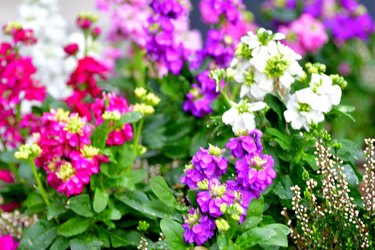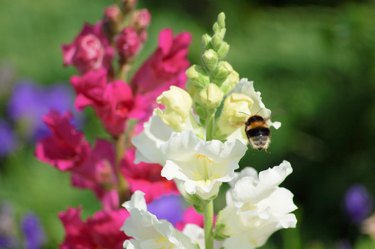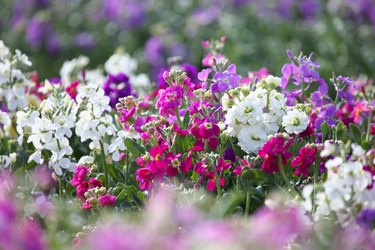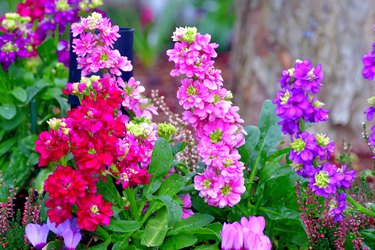
Gardeners select their flowers for all sorts of reasons. Two of the most compelling are beautiful blossoms and rich, pleasant fragrances—and, luckily, a few flowers combine both. Stock flowers (Matthiola incana and the related Matthiola sp.) are on that list. They're wonderful cut flowers, and their scent is heady and spicy, featuring hints of clove. One of their only shortcomings as a garden flower is that they don't tolerate heat very well. Depending on your climate, this can mean that they won't blossom (or won't blossom reliably) all through the summer. Here's what you need to know.
Growing Stocks Based on Your Zone
Video of the Day
In its native habitat (much of Europe, the Mediterranean and the Middle East), stock is a short-lived perennial that develops somewhat woody stem bases. It can be grown as a perennial on this side of the Atlantic as well in USDA plant hardiness zones 7-10. In zones with a mild winter, it can also be grown as a biennial, becoming established in its first year and blossoming in the second after overwintering. The plant endures light frosts, but subfreezing temperatures can halt growth, cause dieback and make it unusually short before flowering. In zones with hard-freezing winters, growing stocks as annuals is the best option.
Video of the Day

Stock, whether grown as a perennial, biennial or annual flower, needs cool temperatures to yield flowers. Temperatures in the range of 50-70°F help seeds germinate while promoting good leafy growth and upright flower clusters. On the other hand, temperatures above 80°F create a condition called blinding. The overly warm conditions create upright stems or spikes without any flowers followed by plant decline. In areas with a hot summer, then, you can expect the fragrant blossoms to stop once summer temperatures reach their peak.
Gardeners in a mild climate can plant stock in fall and winter for early spring blossoms. Everywhere else, plan to transplant in early spring for blooms in late spring and early summer. In either case, you can then have a midsummer planting for fall blossoms. In cool-summer climates, especially at higher elevations, you might find that you're able to enjoy stock blossoms all summer long, but this is the exception rather than the rule.

Tip
If you have your heart set on richly scented blossoms that produce reliably all summer, consider Sweet William (Dianthus barbatus) as an alternative. It’s perennial in USDA zones 3-9, has beautiful blossoms in its own right (they’re related to carnations) and its blossoms have a spicy note that’s reminiscent of (and compatible with) the clovelike scent of stocks. Unlike stocks, though, Sweet William will bloom reliably throughout the gardening season as long as you’re diligent about deadheading spent blossoms.
Types of Stock Flowers
You might know them by their common names, as "gillyflowers" or "perfume plants" (or even "hoary stock" because of the fine hairs on their stems), but horticulturists tend to group stock into four varieties.
Brompton types grow as two-year biennial plants and produce tall plants with upright cluster spikes of single or double flowers. East Lothian stocks are smaller with more compact flower spikes and are grown as either biennials or spring annuals. Ten Week stocks are grown as fast-growing cool-season annuals that are either tall or short in stature depending on the individual cultivar.
Column stock refers to cultivars that grow tall with narrow, unbranching flower spikes, making them ideal cut flowers for production in fields or greenhouses. Stock cultivars are often sold and marketed as series, with similar stature cultivars grouped with an array of flower colors. Names of stock series include Cinderella, Giant Imperial, Harmony, Vegmo and Cheerful.

Modern stock varieties are often hybrids derived by interbreeding Matthiola incana with close cousins, such as M. odorata and M. sinuata. A rather different cousin, M. longipetala, is known under the name "evening scented stock" or "night scented stock." It's not the most impressive of flowering plants, with small and wispy blossoms that only open at night, but it's notable for its fragrance even in this highly scented family. It's worth growing a few (you won't need many!) outside your bedroom window or along a back porch where you sit in the evenings just to enjoy the glorious scent.
Tips for Growing Stock Flowers
Sow seeds or transplant seedlings of stock in a garden bed that gets at least partial (and ideally full) sun. They need moist, well-draining soil (they're susceptible to root rot if soil is too damp) that's rich in organic matter. In hot climates, start perennial and biennial plants from seed in summer to grow and flower in the winter and spring months the following year.
Annual stock is easily grown when sown indoors in containers six to eight weeks before the last spring frost date and then later transplanted outdoors. To prolong the supply of flowers, sow annual stock in two-week increments so some plants grow into the flowering stage during months when temperatures remain above 35°F at night but below 85°F during the day. A heavy layer of mulch around stock plants can help retain moisture in dry climates and keep soil temperatures low for a bit longer as the summer heats up (which, in turn, lets you enjoy the stock flowers for longer).

Stocks most commonly have pink flowers, purple flowers or white flowers, though hybrids continually add new hues. Apricot is one popular new cultivar in a delicately apricotlike shade of pale yellow-pink. They're beautiful in conventional beds or in the visually pleasing chaos of a cottage garden.
A common growing tip is to choose your cultivars and planting locations (beds, planters, pots) so blossoms are at nose height for the greatest enjoyment of their scent. Select column stocks or other long-stemmed varieties for florist-style formal bouquets and flower arrangements, though any of the stocks will make a wonderfully colorful and fragrant addition to your at-home vases.
Here's to your most beautiful blooms ever!